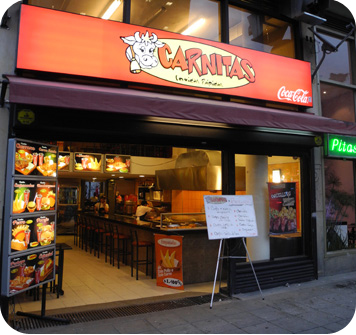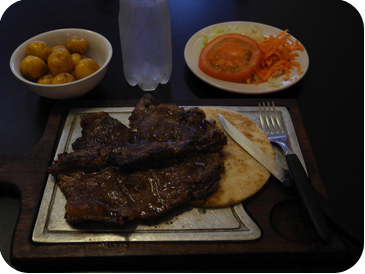Paleo Fast Food in the Developing World
 Sunday, March 20, 2011 at 08:22PM
Sunday, March 20, 2011 at 08:22PM  Guest Post by John Michael
Guest Post by John Michael
Tired and stressed from work, low on money, and pressed for time, the other day I walked into a fast-food restaurant in Bogotá called Carnitas, which in English might best be translated as either “Little Meats” or “Meaties.” Expecting to find within the standard selection of American fast-food items, like hamburgers, pizzas, and hot dogs, all made from unknown ingredients of a dubious origin, I was surprised to find, alongside these items, a variety of steaks.
Both intrigued and enticed by this discovery, I ordered a churrasco combo, which consisted of a rump-steak filet atop a cornmeal tortilla, a side salad, a bowl of steamed Andean potatoes, and a bottle of water. I sat looking at the food arrayed before me, and realized that if I’d held the tortilla and the potatoes, and perhaps requested a bit more salad in exchange, then this meal would actually have been quite Paleo.
If you’re like me, then you know that fast food is generally bad for you. Whenever I walk into a fast-food restaurant, I have to make an effort not to be driven back out of the restaurant’s front doors by the horror stories that I’ve heard. Whether it’s the story of the factories in New Jersey where the scents for hamburger meat and French fries are manufactured, or the story of the meat that’s not really meat, but instead an amalgam of non-meat ingredients concocted by some mad food scientist, American fast-food restaurants have gained a notoriety of mythical proportions in recent years.
As I ate my steak and salad, I began to wonder why it was that a Carnitas in Colombia would have on its menu what an American fast-food restaurant would not, namely, a remarkably healthy and, if not delicious, then at least sufficiently palatable option. My curiosity led me to later research the Colombian agricultural sector, and while doing so I discovered that Colombia’s farms are currently transitioning from providing for domestic consumption to becoming players in the international market.
Friends of mine here had mentioned in passing how only a few years ago it was uncommon to see the processed foods that are now ubiquitous on the shelves of supermarkets and corner stores in Bogotá. The presence of these processed foods was made possible by the Colombian government’s policy of apertura, or “economic openness,” which has increased food imports, and so, perhaps unintentionally, caused “Colombia's overall food self-sufficiency ratio [to fall] from 95 percent in 1990 to 84 percent in 1996.”
 Hold the potatoes and the tortilla and you have a Paleo meal.As it turns out, the churrasco combo that I ate at Carnitas was an example of comida típica, or a typical Colombian meal. But even these traditional dishes are changing here as more people purchase microwaves, because “U.S. frozen prepared meals, vegetables and pastry products have significant marketing potential and face little competition from competing suppliers,” and so become a part of the typical Colombian diet.
Hold the potatoes and the tortilla and you have a Paleo meal.As it turns out, the churrasco combo that I ate at Carnitas was an example of comida típica, or a typical Colombian meal. But even these traditional dishes are changing here as more people purchase microwaves, because “U.S. frozen prepared meals, vegetables and pastry products have significant marketing potential and face little competition from competing suppliers,” and so become a part of the typical Colombian diet.
In their March 2009 report regarding the Colombian Free Trade Agreement entitled, A Bitter Harvest for Colombian Agriculture in the FTA, the organization RECALCA (Red de Acción Colombiana Frente al Libre Comercio) paints a somber picture of the future created by the Colombian government’s pursuit of the transformation of its agricultural sector.
“Its strategy for national and agricultural growth relies on the development of export capacity for the following items: tobacco, manioc, cotton, potatoes, cocoa, bell peppers, broccoli, onions, asparagus, red peppers, lettuce, capers, uchuva [cape gooseberry], banana, tahiti lemons, maracuyá [passion fruit], pitahaya [yellow dragon fruit], pineapple, mangoes, Feijoa [pineapple guava], cut [oak, pine, teak, Melina] lumber, sugar cane and palm oil (for bio-fuel). These items do not constitute a basic diet for human beings. By way of the FTA the Colombian government aims to turn the country’s agriculture solely into tropical crops while importing, in exchange, food staples from the United States. This will lead to the loss of Colombian food sovereignty.
“As a result of the FTA, at least 365,000 hectares will be pulled out of production. Some 86,000 peasants, having lost their livelihood, will have to find other means of survival. Some will move to cities to live in the urban villa-miserias. Other will turn, as a last resort, to coca growing. The lack of economic opportunity in Colombia’s rural areas is the fuel that feeds the scourge of violence afflicting the country. The situation worsens given the cutbacks in agricultural protection resulting from trade liberalization policies.”
The steak and salad that I had at Carnitas the other day was a relic of the old Colombian diet, an example of the meals that Colombians typically ate before their agricultural economy began to shift toward providing the world market with staple foods, which are now being purchased by multinational corporations that mix and process these staples, and then sell the final product back to the Colombians. If this trend continues, it will only be a matter of time before the modern diseases associated with the industrial diet that are currently plaguing the United States begin to appear here as well.
Posted by John Michael



Reader Comments